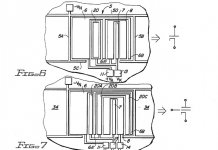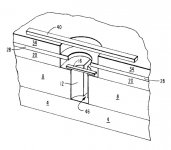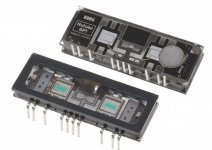Audiphools spend their life trying to get synergy, and matching amps and cables to speakers (or even matching speakers to their amps). Why not take a systems approach and try to make things actually better!
Hear, hear!!
//
on op-amps:
was reading the RCA 1952 tube manual this morning and intermod distortion takes leading role in distortion measurements.
I have a good audio test system but no intermod feature.
Could IM be the good / no-good test for op-amps?
-
Most of today's gear will do an IM test.
SMPTE IM won't do any better than harmonic distortion, perhaps even worse. It used to be the standard for tube amps, but it only senses distortion of the 50-60 Hz waveform, not anything higher. uA741's, for example, did pretty well with SMPTE IM. CCIF IM (19-20KHz) could be VERY useful, however.
A few other faults with op-amps might include:
Optimal small signal resistor values depend on and is different depending on power voltage used. This also makes the datasheet example schematic accuracy, a rarity.
Ignoring the effectiveness of even the most simplistic power filtering in trade for promoting power noise rejection as a cure-all.
Optimizing these is considerably less convenient than advertised. I do wish there was room to fit a few more ccs in those little packages! The amount of labor to manually trim these, is not well documented. Instead, the datasheets (aka advertisements) tend to claim that one schema works for every task imaginable, same for every op-amp, even though that is not plausible.
Optimal small signal resistor values depend on and is different depending on power voltage used. This also makes the datasheet example schematic accuracy, a rarity.
Ignoring the effectiveness of even the most simplistic power filtering in trade for promoting power noise rejection as a cure-all.
Optimizing these is considerably less convenient than advertised. I do wish there was room to fit a few more ccs in those little packages! The amount of labor to manually trim these, is not well documented. Instead, the datasheets (aka advertisements) tend to claim that one schema works for every task imaginable, same for every op-amp, even though that is not plausible.
yes, i put local ps filtering / stabilization on every stage. who would not?
i too wondered about the psrr marketing , maybe i was missing something.
-
i too wondered about the psrr marketing , maybe i was missing something.
-
yes, i put local ps filtering / stabilization on every stage. who would not?
i too wondered about the psrr marketing , maybe i was missing something.
-
You might as well ask for 9 legs and a ground pin.
You might as well ask for 9 legs and a ground pin.
Scott,
You are going to need 10 pins to allow the magic transistor capacitor to be connected! I just don't know how you could forget such an important connection.
Now if you add two more we can have a place to insert the carbon composition resistor in the VAS stage for even more improvement.
But I know the audio market is just too small for such a device...
Scott,
You are going to need 10 pins to allow the magic transistor capacitor to be connected! I just don't know how you could forget such an important connection.
Now if you add two more we can have a place to insert the carbon composition resistor in the VAS stage for even more improvement.
But I know the audio market is just too small for such a device...
We also must include Tom Bearden's Motionless Electromagnetic Generator.
We also must include Tom Bearden's Motionless Electromagnetic Generator.
C'mon Scott,
Don't be silly. You know that is impossible. The powers that be would then block every aspect of it.
I have heard tales and urban myth that at one time they made these DIP packages with 14 pins!! <gasp>
I have heard tales and urban myth that at one time they made these DIP packages with 14 pins!! <gasp>
Back in the days they weren't using any scientific protocol in counting those pins, thus the figure 14 is highly suspicious.

-
more on op-amps , possible fix
I thought a cerdip with nuvistor style socket piggyback might work.( like mostek/hitachi)
A better solution would be a monolithic device in cerdip with integrated 'tube' diff pair. The device matching pair would be incredible.
So the op-amp is a true hybrid with input stage grids etc. +- 24v is adequate.
Heater no problem , old art.
-
more on op-amps , possible fix
I thought a cerdip with nuvistor style socket piggyback might work.( like mostek/hitachi)
A better solution would be a monolithic device in cerdip with integrated 'tube' diff pair. The device matching pair would be incredible.
So the op-amp is a true hybrid with input stage grids etc. +- 24v is adequate.
Heater no problem , old art.
-
Attachments
I forgot the limit but they pushed that form factor several beyond 18 even IIRC until the mechanics became untenable.
I forgot the limit but they pushed that form factor several beyond 18 even IIRC until the mechanics became untenable.
I've used 28 pin DIPs like this one's package.
Microchip Technology Inc. - PIC18F2550-I/SP - SPDIP-28 24 I/O 256 EEPROM 2048 RAM 32 KB Flash Microcontroller - Allied Electronics
I've used 28 pin DIPs like this one's package.
Microchip Technology Inc. - PIC18F2550-I/SP - SPDIP-28 24 I/O 256 EEPROM 2048 RAM 32 KB Flash Microcontroller - Allied Electronics
Looks about right, I think anything more went into a wide form factor so as to be less easily warped lengthwise.
Looks about right, I think anything more went into a wide form factor so as to be less easily warped lengthwise.
Microchip is my go-to now on embedded industrical controllers.
the dsPic16 have designed in many.
-
I don't want to kick it much more, here is maybe the ultimate fix for the input pair.
Its used in Korg synths.
link: http://korgnutube.com/pdf/Nutube_DatasheetV1E.pdf
-
Its used in Korg synths.
link: http://korgnutube.com/pdf/Nutube_DatasheetV1E.pdf
-
Attachments
- Status
- Not open for further replies.
- Home
- General Interest
- Everything Else
- What is wrong with op-amps?


